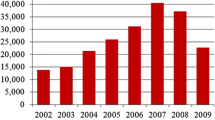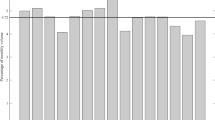Abstract
The author revisits the strategy of trading S&P 500 index re-compositions under the pre- and post-crisis financial environments, proving that the return structure has significantly changed. The results show for the first time that there are currently no tradable abnormal returns between announcement and event dates in the post-crisis sample period, indicating smoother rebalancing mechanisms by bank’s client facing desks and better services for passive end-investors. The newly added firms inflate the S&P 500 index by less than ten basis points per year. The results could be attributed to improved execution algorithms used by the banks and potentially to the new regulatory reforms in the sector, which prevents financial institutions from taking large trading positions with their balance sheets.

Similar content being viewed by others
Notes
Index changes were published every 3–6 months. The Wall Street Journal published index compositions very rarely.
To support this argument, a calculation of betas using a single-index model and a post-event estimation period of 1 year (following the method of Jain 1987) shows that the average level of the added firms’ systematic risk is 1.16.
October 2008 is considered the most appropriate date to divide the sample given the series of financial events (Lehman bankrupty, Fannie Mae and Freddie Mac take over by the US governement, and Merill Lynch take over by Bank of America).
There are only ten firms in the sample that were added to the index more than 7 days following announcement.
References
Amihud, Y., and H. Mendelson. 1987. Trading mechanisms and stock returns: An empirical investigation. Journal of Finance 42 (3): 533–553.
Beneish, M., and J. Gardner. 1995. Information costs and liquidity effects from changes in the Dow Jones industrial average list. Journal of Financial and Quantitative Analysis 30 (1): 135–157.
Beneish, M., and R. Whaley. 1996. An anatomy of the “S&P game”: The effects of changing the rules. Journal of Finance 51 (5): 1909–1930.
Beneish, M., and R. Whaley. 1997. A scorecard from the S&P game: Can I play? Journal of Portfolio Management 23 (2): 16–23.
Beneish, M., and R. Whaley. 2002. S&P 500 index replacements: A new game in town. Journal of Portfolio Management 29 (1): 51–60.
Chakrabarti, R., Huang, W., Jayaraman, N. and J. Lee. 2002. The index effect on stock prices and trading volumes: International evidence. Working Paper Series, Georgia Tech Center for International Business Education and Research, 2002–2003.
Chen, H., G. Noronha, and V. Singal. 2004. The price response to the S&P 500 additions and deletions: Evidence of asymmetry and a new explanation. Journal of Finance 59 (4): 1901–1929.
Cusick, P. 2002. Price effects of addition or deletion from the standard and poor’s 500 index: Evidence of increasing market efficiency. Financial Markets, Institutions and Instruments 11 (4): 349–383.
Deininger C., Kaserer C. and S. Roos. 2000. Stock price effects associated with index replacements in Germany. Working Paper No 7, Free University of Bozen-Bolzano.
Denis, D., J. McConnell, A. Ovtchinnikov, and Y. Yu. 2003. S&P 500 index additions and earnings expectations. Journal of Finance 58 (5): 1821–1840.
Dhillon, U., and H. Johnson. 1991. Changes in the standard and poor’s 500 list. Journal of Business 64 (1): 75–85.
Doeswijk, R. 2005. The index revision party. International Review of Financial Analysis 14 (1): 93–112.
Edmister, R., S. Graham, and W. Pirie. 1994. Excess returns of index replacement stocks: Evidence of liquidity and substitutability. Journal of Financial Research 17 (3): 333–346.
Edmister, R., S. Graham, and W. Pirie. 1996. Trading cost expectations: Evidence from S&P 500 index replacement stock announcements. Journal of Economics and Finance 20 (2): 75–85.
Erwin, G., and J. Miller. 1998. The liquidity effects associated with addition of a stock to the S&P 500 index: Evidence from bid/ask spreads. The Financial Review 33: 131–146.
Goetzmann, W., and M. Garry. 1986. Does delisting affect stock price? Financial Analyst Journal 42 (2): 64–69.
Harris, L., and E. Gurel. 1986. Price and volume effects associated with changes in the S&P 500 list: New evidence for the existence of price pressures. Journal of Finance 41 (4): 815–829.
Jacques, W. 1988. The S&P 500 membership anomaly, or would you join this club? Financial Analyst Journal 44 (6): 73–75.
Jain, P. 1987. The effect on stock price of inclusion or exclusion from the S&P 500. Financial Analysts Journal 43 (1): 58–65.
Kappou, K., C. Brooks, and C.W. Ward. 2010. The S&P 500 index effect reconsidered: Evidence from overnight and intraday stock price performance and volume. Journal of Banking & Finance 34 (1): 116–126.
Kappou, K., and I. Oikonomou. 2016. Is there a gold social seal? The financial effects of additions to and deletions from social stock indices. Journal of Business Ethics 133 (3): 533–552.
Kaul, A., V. Mehrotra, and R. Morck. 2000. Demand curves for stocks do slope down: New evidence from an index weights adjustment. Journal of Finance 55 (2): 893–912.
Kim, S. 2013. The timing of opening trades and pricing errors. Financial Management 42 (3): 503–516.
Lamoureux, C., and J. Wansley. 1987. Market effects of changes in the standard and poor’s 500 index. The Financial Review 22 (1): 53–69.
Liu, S. 2006. The impacts of index rebalancing and their implications: Some new evidence from Japan. Journal of International Financial Markets, Institutions and Money 16 (3): 246–269.
Madhavan, A. 2003. The russell reconstitution effect. Financial Analysts Journal 59 (4): 51–64.
Malkiel, B., and A. Radisich. 2001. The growth of index funds and the pricing of equity securities. Journal of Portfolio Management 27 (2): 9–21.
Mazouz, K., and B. Saadouni. 2007. The price effects of FTSE 100 index revision: What drives the long-term abnormal return reversal? Applied Financial Economics 17 (6): 501–510.
Pruitt, S., and J. Wei. 1989. Institutional ownership and changes in the S&P 500. Journal of Finance 44 (2): 509–513.
Shleifer, A. 1986. Do demand curves for stocks slope down? Journal of Finance 41 (3): 579–590.
Stoll, H., and R. Whaley. 1990. Stock market structure and volatility. Review of Financial Studies 3 (1): 37–71.
Woolridge, R., and C. Ghosh. 1986. Institutional trading and security prices: The case of changes in the composition of the S&P 500 index. Journal of Financial Research 9 (1): 13–24.
Wurgler, J., and E. Zhuravskaya. 2002. Does arbitrage flatten demand curves for stocks? Journal of Business 75 (4): 583–608.
Author information
Authors and Affiliations
Corresponding author
Rights and permissions
About this article
Cite this article
Kappou, K. The diminished effect of index rebalances. J Asset Manag 19, 235–244 (2018). https://doi.org/10.1057/s41260-018-0077-8
Revised:
Published:
Issue Date:
DOI: https://doi.org/10.1057/s41260-018-0077-8




